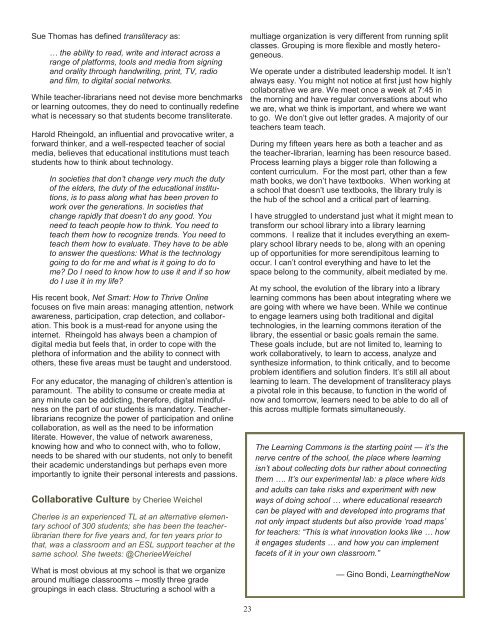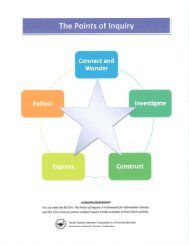FROM SCHOOL LIBRARY TO LIBRARY LEARNING COMMONS:
A source document for transforming K-12 school libraries into Library Learning Commons in BC, developed by the BC Teacher Librarians' Association
A source document for transforming K-12 school libraries into Library Learning Commons in BC, developed by the BC Teacher Librarians' Association
You also want an ePaper? Increase the reach of your titles
YUMPU automatically turns print PDFs into web optimized ePapers that Google loves.
Sue Thomas has defined transliteracy as:<br />
… the ability to read, write and interact across a<br />
range of platforms, tools and media from signing<br />
and orality through handwriting, print, TV, radio<br />
and film, to digital social networks.<br />
While teacher-librarians need not devise more benchmarks<br />
or learning outcomes, they do need to continually redefine<br />
what is necessary so that students become transliterate.<br />
Harold Rheingold, an influential and provocative writer, a<br />
forward thinker, and a well-respected teacher of social<br />
media, believes that educational institutions must teach<br />
students how to think about technology.<br />
In societies that don’t change very much the duty<br />
of the elders, the duty of the educational institutions,<br />
is to pass along what has been proven to<br />
work over the generations. In societies that<br />
change rapidly that doesn’t do any good. You<br />
need to teach people how to think. You need to<br />
teach them how to recognize trends. You need to<br />
teach them how to evaluate. They have to be able<br />
to answer the questions: What is the technology<br />
going to do for me and what is it going to do to<br />
me? Do I need to know how to use it and if so how<br />
do I use it in my life?<br />
His recent book, Net Smart: How to Thrive Online<br />
focuses on five main areas: managing attention, network<br />
awareness, participation, crap detection, and collaboration.<br />
This book is a must-read for anyone using the<br />
internet. Rheingold has always been a champion of<br />
digital media but feels that, in order to cope with the<br />
plethora of information and the ability to connect with<br />
others, these five areas must be taught and understood.<br />
For any educator, the managing of children’s attention is<br />
paramount. The ability to consume or create media at<br />
any minute can be addicting, therefore, digital mindfulness<br />
on the part of our students is mandatory. Teacherlibrarians<br />
recognize the power of participation and online<br />
collaboration, as well as the need to be information<br />
literate. However, the value of network awareness,<br />
knowing how and who to connect with, who to follow,<br />
needs to be shared with our students, not only to benefit<br />
their academic understandings but perhaps even more<br />
importantly to ignite their personal interests and passions.<br />
Collaborative Culture by Cheriee Weichel<br />
Cheriee is an experienced TL at an alternative elementary<br />
school of 300 students; she has been the teacherlibrarian<br />
there for five years and, for ten years prior to<br />
that, was a classroom and an ESL support teacher at the<br />
same school. She tweets: @CherieeWeichel<br />
What is most obvious at my school is that we organize<br />
around multiage classrooms – mostly three grade<br />
groupings in each class. Structuring a school with a<br />
multiage organization is very different from running split<br />
classes. Grouping is more flexible and mostly heterogeneous.<br />
We operate under a distributed leadership model. It isn’t<br />
always easy. You might not notice at first just how highly<br />
collaborative we are. We meet once a week at 7:45 in<br />
the morning and have regular conversations about who<br />
we are, what we think is important, and where we want<br />
to go. We don’t give out letter grades. A majority of our<br />
teachers team teach.<br />
During my fifteen years here as both a teacher and as<br />
the teacher-librarian, learning has been resource based.<br />
Process learning plays a bigger role than following a<br />
content curriculum. For the most part, other than a few<br />
math books, we don’t have textbooks. When working at<br />
a school that doesn’t use textbooks, the library truly is<br />
the hub of the school and a critical part of learning.<br />
I have struggled to understand just what it might mean to<br />
transform our school library into a library learning<br />
commons. I realize that it includes everything an exemplary<br />
school library needs to be, along with an opening<br />
up of opportunities for more serendipitous learning to<br />
occur. I can’t control everything and have to let the<br />
space belong to the community, albeit mediated by me.<br />
At my school, the evolution of the library into a library<br />
learning commons has been about integrating where we<br />
are going with where we have been. While we continue<br />
to engage learners using both traditional and digital<br />
technologies, in the learning commons iteration of the<br />
library, the essential or basic goals remain the same.<br />
These goals include, but are not limited to, learning to<br />
work collaboratively, to learn to access, analyze and<br />
synthesize information, to think critically, and to become<br />
problem identifiers and solution finders. It’s still all about<br />
learning to learn. The development of transliteracy plays<br />
a pivotal role in this because, to function in the world of<br />
now and tomorrow, learners need to be able to do all of<br />
this across multiple formats simultaneously.<br />
The Learning Commons is the starting point — it’s the<br />
nerve centre of the school, the place where learning<br />
isn’t about collecting dots bur rather about connecting<br />
them …. It’s our experimental lab: a place where kids<br />
and adults can take risks and experiment with new<br />
ways of doing school … where educational research<br />
can be played with and developed into programs that<br />
not only impact students but also provide ‘road maps’<br />
for teachers: “This is what innovation looks like … how<br />
it engages students … and how you can implement<br />
facets of it in your own classroom.”<br />
— Gino Bondi, LearningtheNow<br />
23






